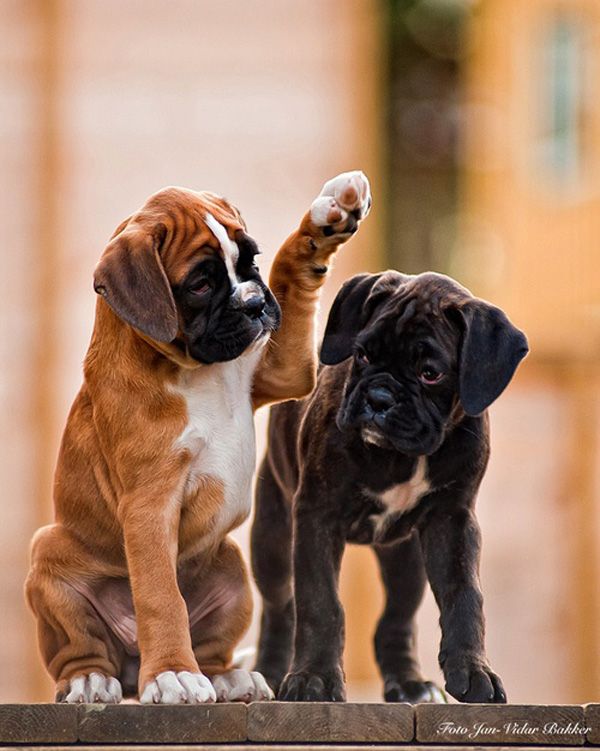About Us
About Us
We are a family-owned commercial dog breeder approved to breed due to our exceptional ethical standards, extensive knowledge and qualifications in animal biology, health canine psychology, breeding, raising and training over the past ten years.
Aside from this, we have our primary jobs that keep us busy, and sometimes, we migrate a lot.
With ten years of experience and a passionate and dedicated team, we are trusted experts in this industry with a wealth of knowledge and the resources to care for, train, and socialise our animals.
As ethical breeders, concern for the health and well-being of our puppies is paramount and will always be a priority before profits. Our core values ensure that our dogs receive enrichment and an excellent quality of life.
Our animals are our passion, and even though our primary jobs take us off from time to time, we have a team put in place 24 hours a day, seven days a week, for every one of our puppies.

Boxer History
The Boxer’s ancestors were the German Bullenbeisser, a dog descended from Mastiffs, and the Bulldog. The Bullenbeisser was used as a hunting dog for centuries to hunt bear, wild boar, and deer, tasked with catching and holding the prey until hunters arrived. Over time, Bullenbeissers lost their jobs on estates and began to be used by farmers and butchers to guard and drive cattle.
The Boxer we know today was developed in the late 19th century when a Munich man named Georg Alt bred a brindle-colored female Bullenbeisser named Flora with a local dog of unknown origin. In the litter was a fawn-and-white male that was named Lechner’s Box, believed to be the start of the line that would become the Boxer we know today. Lechner’s Box was bred to his dam, Flora, and one of the litter was a female called Alt’s Schecken, registered as a Bierboxer or Modern Bullenbeiser.
Schecken was then bred to an English Bulldog named Tom to produce a dog named Flocki, who became the first Boxer to be entered in the German Stud Book after winning at a Munich show that had a special event for Boxers. Flocki’s sister, a white female, was even more influential when she was mated with Piccolo von Angertor, a grandson of Lechner’s Box. One of her pups was a white female named Meta von der Passage, considered to be the mother of the Boxer breed, even though photographs of her show that she bore little resemblance to the modern Boxer.
John Wagner, author of The Boxer, first published in 1939, said the following about her: “Meta von der Passage played the most important role of the five original ancestors. Our great line of sires all trace directly back to this female. She was a substantially built, low to the ground, brindle and white parti-color, lacking in underjaw and exceedingly lippy. As a producing bitch few in any breed can match her record. She consistently whelped puppies of marvelous type and rare quality. Those of her offspring sired by Flock St. Salvator and Wotan dominate all present-day.”
In 1894, three Germans named Roberth, Konig, and Hopner decided to stabilize the breed and put it on exhibition at a dog show in Munich in 1895, founding the first Boxer Club the next year. The breed became known in other parts of Europe in the late 1890s. Around 1903, the first Boxers were imported into the U.S. The first Boxer was registered by the American Kennel Club in 1904, a dog named Arnulf Grandenz. In 1915, the American Kennel Club (AKC) recognized the first Boxer champion, Sieger Dampf v Dom, owned by Governor and Mrs. Lehman of New York.
When Word War I broke out, Boxers were enlisted into the military, serving as messenger dogs, carrying packs and acting as attack and guard dogs. Boxers started becoming popular in the U.S. in the 1940s when soldiers coming home from World War II brought their Boxer mascots with them. Through them, the breed was introduced to more people and soon became a favorite companion animal, show dog, and guard dog.
The American Boxer Club (ABC) was formed in 1935 and gained acceptance by the AKC in the same year. In the early days, there was a lot of controversy within the club about the Boxer standard. In 1938, the club finally approved a new standard. The latest revisions of the standard were in 2005. Today, the Boxer ranks 7th among the 155 breeds and varieties registered by the AKC.
